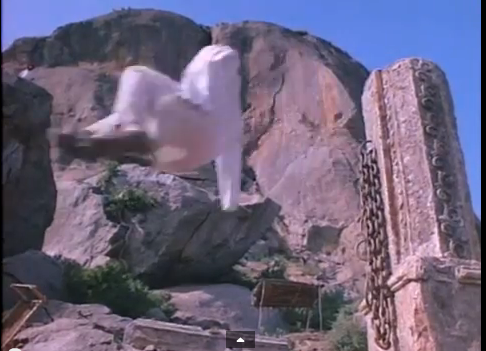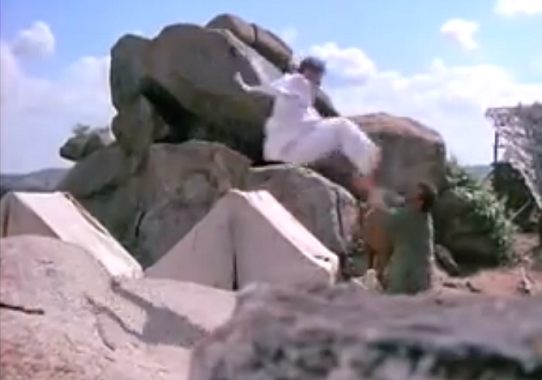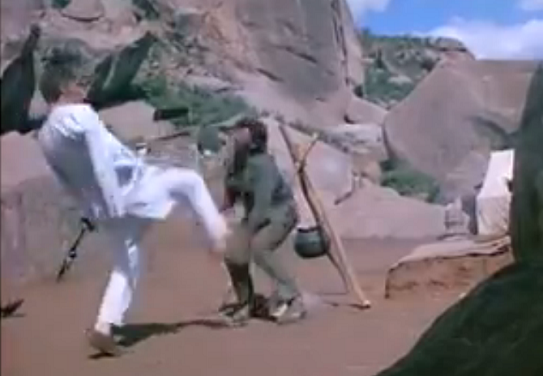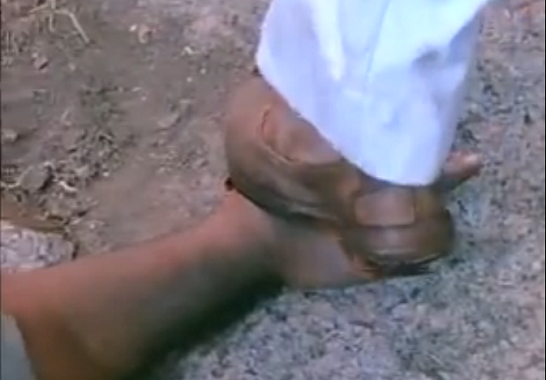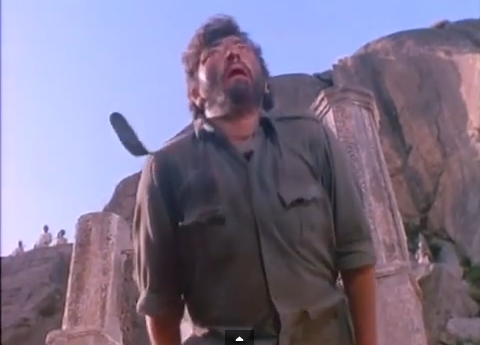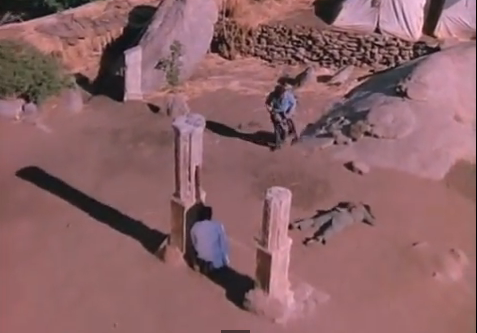Sholay
(→See also) |
|||
| Line 148: | Line 148: | ||
In 2014, a 3D version of Sholay was released with the previously deleted 16 minutes. [https://www.youtube.com/watch?v=psoVNzD4OKI '' Sholay 3D '' (2014)] | In 2014, a 3D version of Sholay was released with the previously deleted 16 minutes. [https://www.youtube.com/watch?v=psoVNzD4OKI '' Sholay 3D '' (2014)] | ||
=See also= | =See also= | ||
| − | [[70mm films in India/ South Asia]] which, inter alia, pictorially demonstrates how | + | [[70mm films in India/ South Asia]] which, inter alia, pictorially demonstrates how ''Sholay'' was blown up from 35mm to 70mm. |
Revision as of 23:01, 18 March 2014
Contents[hide] |
Sholay (1975)
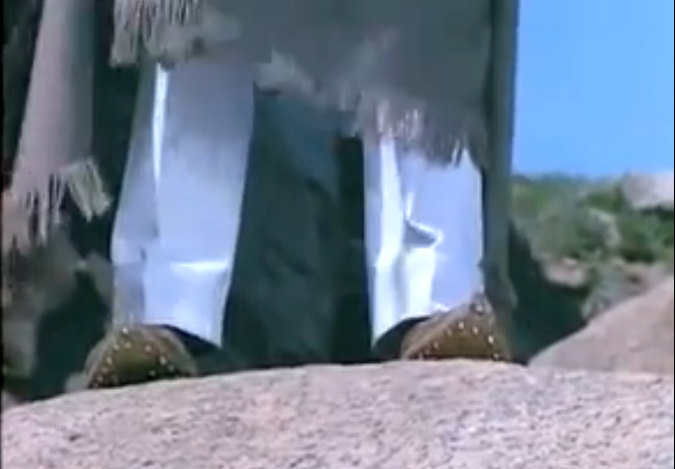
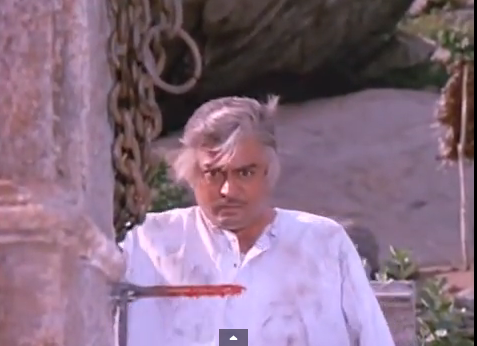
Crew
Director: Ramesh Sippy
Writers: Salim-Javed (Salim Khan, Javed Akhtar)
Produced by G.P. Sippy
Director of photography: Dwarka Divecha ...
Sound re-recording: Mangesh Desai ...
Film Editor: M.S. Shinde
Production Company: United Producers, Sippy Films
Cast
Dharmendra: Veeru
Sanjeev Kumar: Thakur Baldev Singh
Hema Malini : Basanti
Amitabh Bachchan : Jai
Jaya Bhaduri: Radha
Amjad Khan : Gabbar Singh
A.K. Hangal : Imam Saheb
Satyen Kappu : Ramlal
Iftekhar : Narmala ji (Radha's father)
Leela Mishra : Mausi
Vikas Anand: Jailor
Mac Mohan: Saamba
Keshto Mukherjee: Hariram
SachinV Ahmed
Master Alankar Joshi: Deepak
Viju Khote: Kaalia
Major Anand and Bihari: The two dacoits whom Gabbar kills because they were funks (jo dar gaya)
Asrani: The 'British-era Jailor'
Gita Siddharth: Deepak's mother
Helen: ‘Mehbooba,’ the gypsy dancer
P. Jairaj: Police chief
Jagdeep: Soorma Bhopali
Jalal Agha: The one who sings ‘Mahbooba’
Om Shivpuri: Inspector Saheb
Sharad Kumar: Ninni
Technical Specifications
Runtime: 188 min/3:08 hrs (version released in 1975); 204 minutes/ 3:24 hours (3D version released in 2014).
Sound Mix: 6-Track stereophonic (on 70 mm prints)| Mono (on 35 mm prints)|
Color: EastmanColor
Aspect Ratio: 1.37 : 1 (original negative) / 2.20 : 1 (70 mm prints)
Country: India
Language: Hindi
Release Date: 15 August 1975 (India)
Outdoor shooting at: ‘Sippyvaram’/ Ramnagram village on the Mysore-Bangalore highway, Karnataka, India
Songs
All lyrics by Anand Bakshi
All music credited to Rahul Dev Burman, including a song not composed by him.
Holi Ke Din Sung byKishore Kumar & Lata Mangeshkar
Jab Tak Hain Jaan Sung byLata Mangeshkar
Koi Haseena Sung byKishore Kumar
Mehbooba O Mehbooba Sung byRahul Dev Burman (based on Demis Roussos’ Say you love me)
Sholay Title Theme
Yeh Dosti (happy version) sung by Kishore Kumar & Manna Dey
Yeh Dosti (Sad Version) Sung by Kishore Kumar
"Chaand Sa Koi Chehra": the song not used in Sholay
In addition, a qawwali, "Chaand Sa Koi Chehra," had been recorded for the film (and sung by Kishore Kumar, Manna Dey, Bhupendra Singh and, above all, lyricist Anand Bakshi) but never used. In the film it was supposed to be sung by Jai, Veeru and fellow inmates during their stint in jail. The song was never shot because it would have added to the already considerable length of the film, director Ramesh Sippy told an online channel. G9 Premiers, on which you can hear roughly 40 seconds, from 2.00 to 2.40. You can hear 5:49 minutes (i.e. almost the entire song) juxtaposed quite cleverly on a 'fake' video [1]. The lip--synching is nowhere near perfect, but still quite good. The 'fake' video is a qawwali filmed on Dharmendra and Amitabh Bachchan in the 1977 film Charandas.
Censored sequences
Sholay was released just six or seven weeks 'a state of emergency' was declared on India. This included, for the first and last time in the history of independent India, press censorship. A squeaky clean family film like Sholay ought to have had nothing to worry about from the pre-June 1975 film censors of India.
However, the Emergency censors decided that even violence of the kind normal in Disney cowboy films was too much for India's gentle audiences. No film could have more than six minutes of violence and no 'violent' sequence could last more than a minute. Fisticuffs had, in the early 1970s,been the mainstay of India's commercial films, in Hindi-Urdu as well as Tamil and Telugu. Because of the Emergency, most commercial filmmakers opted for scripts that had a quota of six one-minute sequences per film-more was out of question because of the censors, and less was not acceptable to mass audiences. Some films (e.g. Khoon Pasina) want to show more action than that. So,they awarded themselves additional action scenes in which the two antagonists (normally the hero and the villain) chased each other, lunged towards each other, wielded lathis (long batons) but did not actually touch each other in sequences that exceeded the six-minute quota.
By the time Sholay was released the six-minute quota had not been imposed. But the censors deleted three sequences, the last of which was critical to the story. In it the Thakur, whose arms had been chopped off by Gabbar, the villain, decides to kill Gabbar with his feet--with little metal spikes studded on the soles of his shoes.The spiked-shoe climax, 7.11 minutes The censors got this sequence replaced by one in which the police arrives in the proverbial 'nick of time' and takes Gabbar into custody.
Because this sequence was deleted, a shorter sequence in which a village cobbler studs the Thakur's shoes with metal spikes, became meaningless. The film's makers deleted it on their own.
A third sequence that shows how Gabbar kills young Ahmed (Sachin), too, was chopped off by the censors.Ahmed’s murder: 2.48 minutes
Since the early years of the 2st century, unauthorised DVDs crafted by Indians living in the West have been available in which the sixteen deleted minutes have been added where Salim-Javed and Ramesh Sippy had intended them to be. Most of those 16 minutes are also available on YouTube.
In 2014, a 3D version of Sholay was released with the previously deleted 16 minutes. Sholay 3D (2014)
See also
70mm films in India/ South Asia which, inter alia, pictorially demonstrates how Sholay was blown up from 35mm to 70mm.
